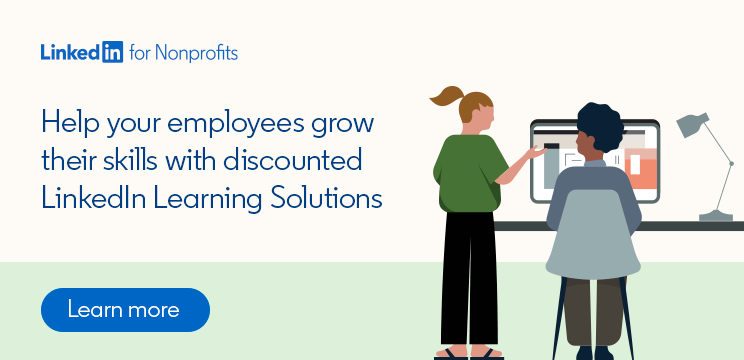
Building a Nonprofit Professional Development Program That Works
The 2023 Workplace Learning Report from LinkedIn highlights two reasons why building nonprofit professional development programs at your organization is a worthy focus:
Job skills are changing fast: Skill sets for jobs have changed by around 25% since 2015 and will change by up to 50% by 2027. With so much change on the horizon, 89% of learning and development professionals agree that building employee skills will help organizations navigate the evolving future of work.
Retention continues to be a big challenge, and internal mobility is an answer: Globally, 93% of organizations are concerned about employee retention, and their No. 1 initiative for improving it is “providing learning opportunities.” Employees who have made an internal move within their organization have a 75% of staying there after two years, whereas employees who haven’t only have a 56% chance of sticking around.
Despite this, only 14% of employee's say their organization encouraged them to build a new career development plan in 2023. If these opportunities are being offered, many employees are not aware of or making full use of them.
To address this, nonprofit organizations can more closely tailor their nonprofit professional development programs to the goals and interests of nonprofit talent. Here are four ways you can make that happen.
1. Connect professional development opportunities to clear career goals
According to the Workplace Learning Report, employees’ top motivation to learn at work is the desire to make progress toward their career goals, followed by the need to stay up to date in their fields. Designing your professional development program around these motivations can encourage your nonprofit employees and volunteers to engage with it.
Get to know your employees’ career goals and help them develop the professional skills they’ll need to achieve them. Pay special attention to how each employee’s current or aspirational roles are changing as the world of work evolves, and ensure your development programs are flexible enough to adapt.
2. Deputize managers to tie professional development goals directly to progress check-ins
Manager support can have a big impact on an employee's engagement with development programs — but only 35% of professionals were encouraged to learn by their manager in the past six months.
Make professional development check-ins a regular part of each team member’s relationship with their manager. Empower managers to provide the resources your nonprofit employees need to acquire the skills they want. Most importantly, encourage your managers to consider their team’s professional development one of their key responsibilities.
3. Give your team opportunities to learn anything they want
Giving employees the opportunity to pursue all of the skills they’re interested in — not just those that apply to their current role — can go a long way toward incentivizing those employees to invest in your career development program.
Toronto-based nonprofit Achēv offers an example of how to make this work. After its team doubled in size, the organization suddenly needed to upskill and reskill a large number of employees quickly. Director of Human Resources Marwa Gamil hoped to implement a professional development program that would fully engage these new employees from the start.
Marwa invested in LinkedIn Learning and then encouraged her team to “go bananas” by exploring the platform’s extensive suite of on-demand resources and courses.
“I mentioned that there were over two thousand learning opportunities,” she says, “and encouraged everyone to go bananas, and learn whatever they wanted to learn.”
Marwa credits this approach as a core reason that her nonprofit’s program has been successful, and advises others to follow suit.
“Organizations always plan learning initiatives based on what they think people should know,” she says, “but that doesn’t give space for people to go in and learn what they want — when you have a platform like [LinkedIn Learning], you give them the gift to explore their interests in addition to what you need from them.”
4. Prioritize time for professional development on the job
According to the 2023 Workplace Learning Report, almost three out of four (74%) of employees want more time to learn during work, and say that having that time would allow them to invest more deeply in professional development resources. Set aside dedicated time for on-the-job learning whenever possible, and encourage managers to make sure their teams have time to learn.
Another effective way to engage nonprofit talent with your development program is to pair employees with more senior coworkers who can act as “mentors.”
By creating opportunities for mentors to train and provide guidance to their less experienced colleagues, you can make the most of your nonprofit’s human resources, foster deeper connections between employees, and improve engagement with professional development programs.
When they understand what you’re offering and that you’re truly committed to their success, your nonprofit team will be more likely to engage with your professional development opportunities. Building this understanding requires a combination of providing the right incentives, communicating effectively, and removing roadblocks.
By following these steps and making your nonprofit professional development as accessible, exciting, and fulfilling as possible, your team members will jump on board in no time — and your organization will benefit for years to come.
For more help creating the right nonprofit professional development opportunities for your organization, see how LinkedIn Learning Solutions for nonprofits can help.

